FLORA AND FAUNA
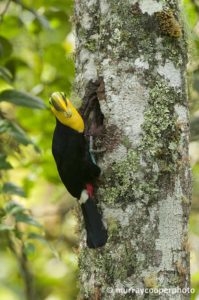
There are more than 400 species of birds in the reserve, with 358 on the reserve bird list as of June 2020. Some of the most endangered birds in Ecuador, such as the critically endangered Black-and-Chestnut Eagle are here, as well as Tanagers, Hawks, Eagles, Parrots, Owls, and Toucans to name but a few. Over a dozen species of hummingbirds whizz around throughout the forest, some only an inch long. The stunning Andean Cock-of-the-Rock, the Toucan Barbet, and the colorful Golden Headed Quetzal make their home here too.
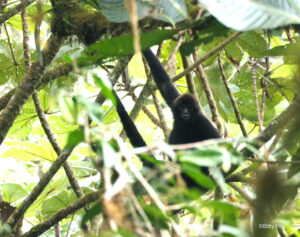
Evidence in the form of scat, tracks, and the occasional sighting provide the assurance that our six species of felines roam their territories here in the reserve. Common names are the Jaguarundi, Margay, Ocelot, Oncilla, Puma, and the western subspecies of Jaguar. In the morning, along with the chorus of birds, you are likely to be woken by the Ecuadorean Mantled Howler Monkey. He is the loudest, so can often be heard, and sometimes seen, in the canopy. The two other primates are the White-Headed Capuchins and the critically endangered Brown-Headed Spider Monkey. The only species of South American bear, the Spectacled Bear, inhabits the higher elevations of the reserve and is seen on occasion.
Other mammals include the Opossum, Nine-Banded Armadillo, Kinkajou, Tayra, Southern River Otter, Collared Peccary, Red Brocket Deer, Paca, Agouti, Spiny Pocket Mouse, Porcupine, Western Dwarf Squirrel, Red-Tailed Squirrel and many species of bats.
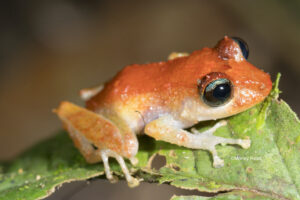
The reserve is also home to numerous species each of snakes, lizards and frogs which are often seen but usually move quickly away. Many of these species are rare and endangered. For example, the reserve has a rainfrog that is only known from Los Cedros, Pristimantis cedros and another that is only known from Los Cedros and one other locality, Pristimantis mutabilis.
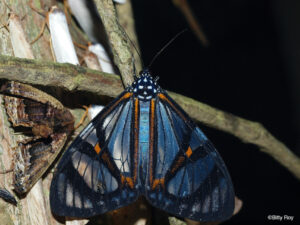
Encompassing thousands of species, the invertebrates dominate the faunal biomass. In Los Cedros there are hundreds of species of nocturnal moths, most with amazing wing patterns and colors. There are also thousands of species of butterflies, ants, beetles, spiders, flies and bees, many of which are undescribed.
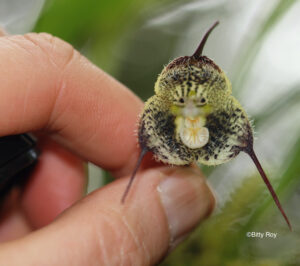
Abundant tree species include Copal, Madroño, Avocatillo, Strangler Fig and Clusia, while the endangered Cedars that give the reserve its name are less numerous. The number of tree species per hectare is very high, estimated to be as many as 400/ha. The dense forest floor and understory is a thick web of buttress roots, lianas, vines, prop roots, drop roots, decomposing plant material and abundant fungi. Characteristic of a cloud forest, the trees on the ridge lines are more stunted in size and laden with masses of luxuriant ephiphytes, with a more open canopy allowing a thicker and richer understory.
Also common in the upper story are climbing philodendrons, bromeliads, and ferns. The area is especially rich in orchids, with more than 200 species identified, many of which were described from the reserve, with Cal Dodson predicting 200 were yet to be discovered.
LOS CEDROS SPECIES LISTS
WHAT IS iNATURALIST?
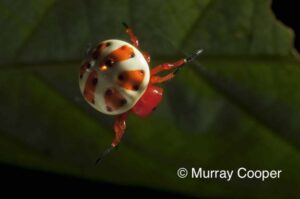
iNaturalist is a joint initiative of the California Academy of Sciences and the National Geographic Society.
iNaturalist observations for Los Cedros give an idea of the diversity at the Reserve.
Every observation can contribute to biodiversity science, from the rarest butterfly to the most common backyard weed. We share your findings with scientific data repositories like the Global Biodiversity Information Facility to help scientists find and use your data. All you have to do is observe.
GEOGRAPHY AND CLIMATE OF LOS CEDROS
 The Toisan mountain range runs East/West off the western side of the Andes mountains. Running North/South from this Toisan range lies the Cordillera de La Plata of which Los Cedros is the Southern most area. The reserve lies on the ascending slopes of the La Plata range consisting of steep river valleys and high ridges. Los Cedros has altitudes ranging from 1,000 meters at the entrance, up to Cerro de La Plata at 2,700 meters. This is the last ridge in the Cordillera de La Plata. The reserve encompasses four main watersheds; the Rio Manduriyacu, the Rio Verde, the Rio Los Cedros, and the south bank of the Rio Magdalena Chico. Keeping these rivers protected and clean for those that live downriver is a main objective for Los Cedros Reserve.
The Toisan mountain range runs East/West off the western side of the Andes mountains. Running North/South from this Toisan range lies the Cordillera de La Plata of which Los Cedros is the Southern most area. The reserve lies on the ascending slopes of the La Plata range consisting of steep river valleys and high ridges. Los Cedros has altitudes ranging from 1,000 meters at the entrance, up to Cerro de La Plata at 2,700 meters. This is the last ridge in the Cordillera de La Plata. The reserve encompasses four main watersheds; the Rio Manduriyacu, the Rio Verde, the Rio Los Cedros, and the south bank of the Rio Magdalena Chico. Keeping these rivers protected and clean for those that live downriver is a main objective for Los Cedros Reserve.
Although only thirty miles north of the equator, the temperature at these altitudes can get pretty chilly at night and when the clouds and rain move in. The temperature generally fluctuates between 16°C and 25°C (61°F and 77°F). Northwest Ecuador is one of the wettest climates on Earth, due to the meeting of the cold Humboldt and the warm Panama currents just off the coast. The drier season is generally from July to October. This high rainfall and 100% humidity much of the day is critical for the plant and animal communities that have evolved in these forests. This is where the flora and fauna of the Central American, Amazonian, and Andean regions overlap, creating one of the most biologically diverse areas on the planet.
